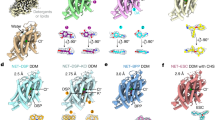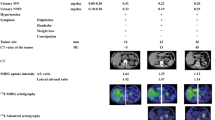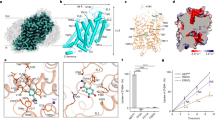Abstract
INTERFERENCE with the release of the adrenergic transmitter, noradrenaline, by chemical blockade of post-ganglionic adrenergic neurones has become anaccepted tool in the management of the hypertensive state1. The chemical structures involved2 indicate that the presence of a cationic head with strong basicity, such as quaternary ammonium or guanidine3, is required for adrenergic neurone-blocking property, imparting a high degree of ionization to the molecule. The molecular mechanism of this type of drug interference is unknown. Failure of nerve impulse transmission, however, might occur by hyper-polarization or by depolarization of the terminal nerve membrane, initiated by the charge-carrying molecules. Significant inhibition of the biosynthesis of the transmitter by the foregoing compounds can be excluded as a possible mode of action on account of more recent work4.
This is a preview of subscription content, access via your institution
Access options
Subscribe to this journal
Receive 51 print issues and online access
$199.00 per year
only $3.90 per issue
Buy this article
- Purchase on SpringerLink
- Instant access to full article PDF
Prices may be subject to local taxes which are calculated during checkout
Similar content being viewed by others
References
Leslie, R. E., Current Therap. Res., 4, 89 (1962). Montuschi, E. F. D., Pearson, H. E. S., and Wilson, L. L., Brit. Med. J., ii, 1199 (1960).
Hey, P., Brit. J. Pharmacol., 7, 117 (1952), Boura, A. L. A., Copp, F. C., and Green, A. F., Nature, 184, BA, 70 (1959). Maxwell, R. A., Mull, R. P., and Plummer, A. J., Experientia, 15, 267 (1959). Walton, E., Nature, 191, 1312 (1961).
Kuroda, A. (Folia Pharmacol. Japan., 19, No. 1 (Opera Orig. 18–31); 1934), claims as far back as 1934 that 3,4-dihydroxybenzyl guanidine and 2-(phenoxy) ethylguanidine reduced the blood pressure on intra venous administration into the rabbit.
Goldstein, M., and Contrera, J. F., Experimentia, 17, 334 (1962).
Bovet, D., and Bovet-Nitti, F., Structure et Activité Pharmacodynamique des Médicaments du Système Nerveux Vegetatif (S. Karger, S. A., Basle, (1948))
Fourneau, E., Maderni, P., and De Lestrange, Y., J. Pharm. et Chim., 18 (3), 185 (1933). Fourneau, E., and Bovet, D., C.R. Soc. Biol., 113, 388 (1933). Gatti, G. C., and Bovet, D., Atti accad. nazl. Luicei, Rend., Classe fis., mat e nat., 14, 645 (1953); Chem. Abstr., 11423d (1954). Marini-Bettòlo, G. B., Landi-Vittory, R., and Bovet, D., Gazz. Chim. Ital., 83, 144 (1953). Marini-Bettòlo, G. B., Renzi, L., Landi-Vittory, R., and Bovet, D., Gazz. Chim. Ital., 87, 1303 (1957). U.S. Patent No. 2,979,511, April 11, 1961; Olin Mathieson Chem. Corp., Chem. Abstr., 18780c (1961). Loubatières, A., Bougard, P., Fruteau De Laclos, C., Sassine, A., and Mariani, M. M., Thérapie, 17, 599 (1962).
Goodman, L., and Gilman, A., The Pharmacological Basis of Therapeutics, second ed. (Macmillan, New York, 1955). Kraumer, L. B., Van Horne, R., Bellet, S., and Koelle, G. B., Amer. J. Med. Sci., 228, 614 (1954).
Rossi, G. V., and Smith, T. H. F., J. Amer. Pharm. Assoc., 46, 472 (1957). Funke, A., Cibraeio, N., and Jacob, J., C.R. Acad. Sci., Paris, 244, 813 (1957).
Henatsch, H. D., Langrehr, D., and Kaese, H. J., Arzneimittelf., 10, 876 (1960). Zervopoulos, G., and Michailides, G., ibid., 12, 161 (1962). French Patent No. 1,315,372, February 14, 1962, Lakeside Labs., Inc.
Author information
Authors and Affiliations
Rights and permissions
About this article
Cite this article
AUGSTEIN, J., GREEN, S. Some New Adrenergic Neurone Blocking Agents. Nature 201, 628–629 (1964). https://doi.org/10.1038/201628a0
Issue date:
DOI: https://doi.org/10.1038/201628a0
This article is cited by
-
Adrenergic Blocking Properties of some New Benzodioxanes
Nature (1965)



